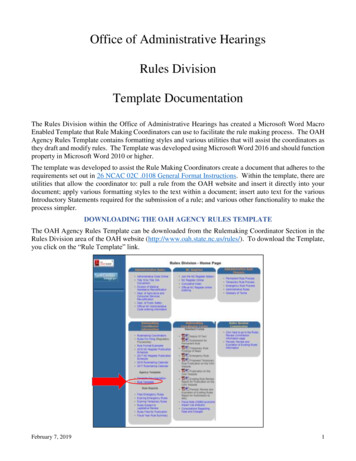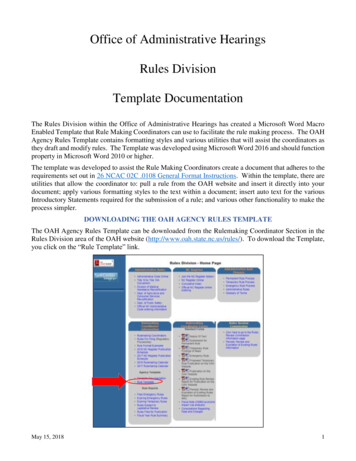
Transcription
Tab CBoard of Zoning AdjustmentDistrict of ColumbiaCASE NO.20505EXHIBIT NO.104C
The DCHistoric AlleyBuildings Survey
The DC Historic Alley Buildings SurveyResearch and Text by Kim Protho Williams, Architectural Historian/National Register Coordinator, DC Historic Preservation OfficeDesign by Kim Elliott, Architect, DC Historic Preservation OfficePublished 2014Unless stated otherwise, photographs and images are from the DC Office of Planning collection.
Table of ContentsIntroduction1Project OverviewStatement of NeedSurvey MethodologyHistoric Context5History of Alleys in Washington, DCSurvey Findings and Statistics11Alley Building DistributionAlley Building Dates of ConstructionAlley Building ibliography43
IntroductionProject OverviewThe D.C. Historic Alley Buildings Survey is an extensive and on-going survey of the city’s historic alleybuildings that began in the Spring of 2011. Thesurvey is being conducted by the D.C. HistoricPreservation Office (HPO) with the assistance ofvolunteers and student interns. The boundariesof the survey were defined to include all of thealleys within the city’s designated historic districts,located within and just beyond the originalL’Enfant Plan (the “Old City”). Phase 1 of the surveycomprises all of those alleys located in the city’snorthwest quadrant historic districts, includingGeorgetown, while Phase 2 of the survey consistsof the Capitol Hill Historic District. Subsequentphases will expand the survey work to other historic districts outside of the original city limits and toareas not designated as historic districts knownto have notable collections of alley buildings.Although the survey project is still on-going, Phase1 and 2 have been substantially completed and itsfindings have been compiled in this report.The Alley Buildings Survey is a basic-level surveydesigned to identify extant alley buildings determined to be 50 years or older. The goal of theproject has been to provide an inventory of thesealley buildings, record basic information aboutthem, research and develop an historic context forbetter understanding and evaluating alley buildings, and to make recommendations for futurepreservation action.Using methodology developed by the HistoricPreservation Office, a team of volunteers andstudent interns collected on-site and archival infor-1ALLEY SURVEYAlley Building Streetscape at the rear of 600 block A Street, NE, Capitol Hill Historic Districtmation, photographed the surveyed alleybuildings and entered the historical and architectural information about the buildings into the city’shistoric buildings survey database (DCHPS) forrecordation and analysis.The following report is a record of the surveyefforts to date. It describes the purpose of thesurvey, details its methodology, provides historical background information for understanding theevolution of the city’s alleyways and alley buildings, and relates and analyzes the findings fromthe survey. Based upon these findings, this reportalso proposes recommendations and strategiesto guide the Historic Preservation Office and theOffice of Planning in the preservation of and urbanplanning for the city’s historic alleyways and itsbuildings.
Statement of NeedAlthough alleyways were not included within theoriginal L’Enfant Plan for the City of Washington,they were introduced into the urban plan in theinitial years of the city’s development, ultimatelybecoming an integral part of its cultural landscape.Due to changing social and economic trends thathave reduced the functional necessity of alleybuildings, they have become increasingly rare, andthose that do survive are often in poor repair andconsidered anachronistic. However, recent studiesand developments in D.C. and other cities showthat “activated” historic alleys can provide distinctive urban spaces that contribute to a vibrant socialrealm. We hope that this study is a step towardsthe re-discovery and re-invention of the city’salleys and its alley buildings.Generally, the city’s alleys and alley buildingshave not been the subject of any comprehensivestudy or documentation effort. Two of the city’ssignificant and adjacent historic alleys—BlagdenAlley and Naylor Court—are exceptional in thisrespect in that they have been officially recognizedfor their intact alley networks and their cohesivecollections of historic buildings. For architecturaland cultural reasons, these alleys have been designated as the Blagden Alley/Naylor Court HistoricDistrict. The historic district is today celebrated asan important cultural landscape and is experiencing physical rehabilitation and social rejuvenation.Similarly, Cady’s Alley in the Georgetown HistoricDistrict has been recently renovated, and itsformerly under-utilized collection of 19th centurystables, warehouses and alley dwellings have beenconverted into an exclusive shopping district filledwith high-end designer show rooms, office spaces,and a restaurant.This Historic Alley Buildings Survey project is thefirst attempt to comprehensively and systematically document the alley buildings within the alleyways of the city’s designated historic districts. Asa rule, at the time that these neighborhoods weredesignated as historic districts, only the buildings facing the city’s principal streets had beenclosely examined. The buildings in the center ofthe squares were generally ignored, leaving anincomplete understanding of the architecturalhistory of these historic districts. A survey of thecity’s alley buildings was needed to enhance thispartial understanding and to provide guidance inthe rejuvenation of the alleyways and their historicbuildings.Cady’s Alley, Georgetown Historic DistrictMap of Prather’s Alley in the Mount Vernon Triangle Historic District showing a dense and varied alleyway of alley dwellings, stables, bakery complex, blacksmith shop,and warehouse. Sanborn Fire Insurance Map, 1904ALLEY SURVEY2
Survey MethodologyThe Survey consisted of an on-site and archivalstudy under the management of the Historic Preservation Office. With current-day maps in hand,survey volunteers walked the identified alleysand updated the maps, identifying extant anddemolished alley buildings. For those extant onesdetermined to be fifty years or older, volunteerscompleted a basic-level survey form and tookphotographs of the buildings. The on-site surveycollected such information as address, buildingtype, building materials, building height, characterdefining features, and notable alterations.Volunteer Surveyor in Dupont Circle Historic DistrictDetail of carriage door, 946 (Rear) T Street, U Street Historic DistrictRecently renovated alley buildings in Blagden Alley3ALLEY SURVEYDetail of stall window on stable in Green Court
An archival study of maps and permits supplemented the on-site information and provideda date of construction (or date range) for thesurveyed building, its original building type/use,and the name of the architect, owner, and builder,if identified. This archival and on-site informationwas then entered into the D.C. Historic Preservation Software system (DCHPS) for later retrievaland analysis. In addition, photographs of all ofthe surveyed alley buildings were uploaded intothe database. Simultaneous to the buildingspecific survey and research, a literature search wasconducted to compile information on the historyof alleys and alley buildings in D.C. This researchwas conducted to provide an understanding of thehistory and evolution of the city’s alleys and alleybuildings. A written overview of this historicalcontext is provided in this document.This established survey methodology resulted inthe successful development of an inventory todate of 1,249 alley buildings. The collection of datahas provided the Historic Preservation Office withan important framework by which to evaluate thesignificance of the surviving alley buildings bothindependently and as a collection, and to begin todevelop a plan for the preservation and “reactivation” of the alleys and their buildings.Building permit from 1907 for private stable (Codman Carriage House),1415 (Rear) 22nd Street, NWAlthough only basic-level survey data wascollected during this phase, the survey providesa comprehensive inventory of historic alley buildings in the selected historic districts. Subsequentphases of the survey will be expanded to includehistoric districts outside of the original city, andareas not currently designated as historic districts.Map of Blagden Alley/Naylor Court Historic District showing buildings by date ofconstructionALLEY SURVEY4
Historic ContextHistory of Alleys in Washington, D.C.“Any court, thoroughfare, or passage, privateor public, thirty feet ormore in width, that doesnot open directly with awidth of at least thirtyfeet upon a public streetthat is at least forty feetwide from building lineto building line ”As the “walking city” began to fill with houses,many of the large and deep lots became subdivided, cutting off the rear of the lots from the publicstreet and creating lots that had frontages solelyon the alleyways. This phenomenon occurredas the city’s population was increasing and landvalues were rising, making alley-facing lots appealing both to property owners who could realizeincome from lot rentals, and to the city’s poorestresidents who could not afford the rents of therow houses lining the public streets. As more andmore interior lots were sold or rented and modesthouses built upon them, there came to be anextensive social system within the interior of theblocks that was wholly independent from theproperties fronting on the surrounding streets. (3)Essentially invisible from the public streets, thesealleys were later dubbed “blind alleys.” According to alley historian James Borchert and earlierresearch, the number of alley dwellings in the citybefore the Civil War was limited, but grew substantially in the decades following it. Prior to the CivilWar, only 348 heads of household were reportedin 49 alleys. These alley dwellings were rentedprimarily to the laboring classes and were 65%white-occupied. (4)Definition of an alley according to the AlleyDwelling Act of 1934Alleyways were introduced into the L’Enfant Planduring the initial years of the city’s establishment.The “Original Survey of Squares” dated 1793-1796,delineates the original city squares, subdividedgenerally with wide and deep lots that were bisected in the center by public alleys. (1) The alleys variedin configuration, but most often had I-shaped orH-shaped forms that stretched 30-feet wide at thecenter of the square and were accessed from thepublic streets by narrower 15-foot alleys. (2)Alleys were planned to provide access to the rearof the large lots which would likely have had kitchens, stables, carts, wagons, and animals, alongwith other dependency buildings, equipment andstorage areas.5ALLEY SURVEYThese plat maps from 1852 (left) and 1874 (right) of Square 140 show the typical evolution of the interior of city squares where large lots that originallyextended from the public streets to rear alleys were divided to create rear lots with frontages solely on the alleys. As shown here, lots 11-12 and 31-33 inthe 1852 plat were subdivided by 1874 for the accommodation of alley dwellings. Atlas of Plat Squares, Washington, D.C., 1852 and Faehtz and Pratt RealEstate Directory of the City of Washington, 1874
Following the Civil War, a large influx of AfricanAmericans into the city greatly increased thenumber of inhabited alleys and reversed the racialmake-up of alley dwellers from white to black.Generally, the alley dwellings were built by whiteproperty owners who realized a considerable rateof return on their investment by building and thenrenting out cheaply constructed alley houses. By1871, the great majority of the city’s alley dwellers remained unskilled workers and 81 percent ofthem were African American. (5)Photograph of children unloading truck in alley in Washington, D.C., Edwin Rosskam photographer, 1941 Library of Congress, Prints & Photographs CollectionThe first alley dwellings were of frame construction with no indoor plumbing or heat. Sharedwater pumps, outhouses and lack of a seweragesystem contributed to unhealthful and insanitary conditions which attracted the attention ofhousing and social reformers. In 1871, the city’sfirst Board of Health was established with theprimary mission being to condemn alley dwellings that were deemed unfit for human habitation.The Board reported that many alleys were “linedon both sides with miserable dilapidated shanties,patched and filthy.” As a result of its findings, theBoard condemned and demolished over 300 alleydwellings and recommended hundreds more forrehabilitation. (6)Within its first ten years of existence, the Board ofHealth was abolished, and condemnation proceedings of alley dwellings were halted. (7) With no morelegal restrictions preventing their construction, thedevelopment of alley dwellings boomed. As rentalrates went unchecked, so did population rates asmore people shared alley dwellings and the rent.This view shows a collection of wood frame dwellings in a D.C. alley. Although thecity’s first alley dwellings were of frame, rather than brick construction, there are noframe alley buildings left in the city. Shorpy.comDuring an alley dwelling building boom in the 1880s, brick replaced frame as theprincipal building material. Shorpy.comALLEY SURVEY6
During the 1880s alley building boom, brickreplaced frame as the principal alley dwellingbuilding material. Despite the brick construction,the houses still lacked basic amenities, including plumbing and running water. Overcrowdingcontinued as extended families shared the smallhouses and even rented out space to borders tohelp cover the rent. The insanitary conditions andthe perceived moral decay of alley inhabitantsagain attracted the attention of housing and socialreformers who mounted campaigns to improvethe living conditions for the alley dwellers. Again,Congress took action and in 1892, it passed alaw that prohibited the erection of dwellings inalleys less than 30 feet wide and not supplied withsewerage, water mains and light. Though no newconstruction was permitted in the alleys by virtueof this law, the ban did not abolish alley housingthat already existed.An 1896 house-by-house investigation of 35 alleysby the Committee on Housing of the Civic Centercompelled the Committee to conclude that thecity’s alleys were unsanitary, overcrowded, andharbored disease and immoral behavior. The physical conditions of the alley dwellings appalled theinvestigators. Houses were described as “beingwithout cellar or attic”; “floors rested upon theearth and were not built to withstand the cold orrain”; “drainage and precautions for cleanlinesswere lacking; and a stench from decomposing ratsand cats and horse manure often permeated thealleyways and alley dwellings.” (8)7ALLEY SURVEYAn inventory of the city’s alleys in 1912 determined that there were 3,337 alley dwellings in the city’s 275 alleys identified as “inhabited.” According to the present survey,108 alley dwellings remain. Notable collections of alley dwellings survive on CapitolHill, in Georgetown and in Foggy Bottom. Three of these—F Street Terrace and Gessford Court on Capitol Hill and Pomander Walk (Bell’s Court) in Georgetown retain allof the original alley dwellings identified in the 1912 inventory. Whether built as partof a row, as a pair, or independently, the alley dwelling is, typologically, a vernacularbuilding that follows the same standard building form. It is invariably a two-story, twobay-wide building set upon a low foundation, and covered with a flat roof.
In 1904, reformers brought the noted humanitarian Jacob Riis to Washington to visit alleys andreport his findings to Congress. This report and thepublicity attending it won over President TheodoreRoosevelt who, in a 1904 Congressional addressconcluded that the“hidden residentialalleys are breedinggrounds of vice anddisease and shouldbe opened into minorstreets.”As quoted in Blagden Alley/Naylor CourtNR nomination, p. 8-16.Following this address, the Board for the Condemnation of Insanitary Buildings was created in 1906with the stated goal being to condemn alley buildings, and to convert the city’s alleys into minorstreets or parks, thereby eliminating the “blind”alleys at the interior of the squares. While thislatter goal proved challenging due to physical andlegal constraints of the city’s alleys, the eradicationof the dwelling units themselves continued by thecity, social reformers, and non-profit organizationsin an episodic manner over the course of severaldecades.Other socio-economic forces also contributed tothe demise of alley dwellings. The introductionand expansion of the city’s streetcar system in thelate 19th century, for instance, allowed for population dispersal beyond the “walking city” therebyreducing the pressure to build housing in theStables, and later garages, began to replace alley dwellings as the principal alleybuilding type during the late 19th and early 20th centuries. Shorpy.comsituated in or adjacent to inhabited alleys in D.C.,for the replatting and improvement of the square.Annual reports by the ADA documented the progress of the its efforts. For instance, in 1936, a list ofthe year’s accomplishments included: the clearingof alley dwellings and “dilapidated street houses”in St. Mary’s Court pending redevelopment; theconstruction of 11 single-family rowhouses inHopkins Place; the construction of an apartmentbuilding in Bland’s Court; construction of threegarages in three different alleys; the sale of alleyacquisitions to private owners for redevelopment;and construction of an automobile repair shop inRuppert’s Court.alleyways. Similarly, the need for horse stablingfacilities (and later garages) further encroachedupon residential life in the alleyways. As Washington grew into a densely developed city, stablingfacilities became indispensable for housing thegrowing population of horses and carriages. Thelargest and most prominent of these livery stablestypically fronted public streets, but others could befound within the city’s alley network next to, and/or replacing alley dwellings. In addition to largelivery stables, alleys offered prime real estate forprivate stables out of sight from the public streets,yet convenient to local residents.The final blow to alley dwellings came in 1934when Congress established the Alley DwellingAuthority (ADA) to eliminate all alley dwellingsand to encourage economic redevelopment ofthe squares. According to the law, no alley houseswere to be inhabited after July 1, 1944. To this end,the ADA was authorized to purchase, or acquire bycondemnation, any land, buildings, or structuresIn 1936, the Alley Dwelling Authority published a report highlighting its annualprogress, showing among other projects, this one in Ruppert’s Court that involvedthe replacement of a row of alley dwellings (top photo) with a garage (bottomphoto). Report of the Alley Swelling Authority, 1936, Historical Society of WashingtonALLEY SURVEY8
The Authority made considerable progress inre-developing the city’s alleys in the 1930s, but theadvent of World War II, and the resulting housingshortage postponed full enforcement of the abolition of alley dwellings. In 1944, an official 10-yearpostponement of the enforcement went intoeffect. In 1953, all alley dwellers were told they hadtwo years to move to street-frontage buildings.By then, however, many of the city’s alley dwellings, namely those in Georgetown, Capitol Hill andFoggy Bottom, had been renovated by wealthywhite residents who rose up in protest. Aided bycitizens groups and preservationists, these ownersbanded together and ultimately succeeded inhaving the Alley Dwelling Act repealed. In publichearings over the issue, residents argued that theyhad essentially fulfilled the basic purpose of thelaw by cleaning up the dangerous eyesores. And,in so doing, the new alley residents of Georgetown argued, they had also brought back some ofGeorgetown’s old Colonial atmosphere. (9)During the 1950s, the local press reported onmany of the renovated alleys, with Schott’s Alleyon Capitol Hill and Snow’s Court in Foggy Bottomgarnering significant attention. Schott’s Alley,renamed Schott’s Court at the time of its renovation, was according to local press, “transformedfrom a rat-infested, overcrowded and rowdy alleyto an L-shaped row of luxury type apartments.”While the social reform movement of the 19th and20th centuries sought to eliminate the unhealthyand dangerous conditions in the city’s alleys toimprove the quality of life for alley dwellers, severalstudies and research by later historians, such asJames Borchert, argued conversely that9ALLEY SURVEYthe efforts more often destroyed communities andupset tight-knit social relationships. In addition,while the crowded and unsanitary conditions inthe alleys reported on by social reformers wereundeniable, those reports on the dangers andevils of the alleys were likely over-exaggerated andmisunderstood. In 1970, Borchert reported thatthere remained at least 20 inhabited alleys in thecity of Washington, a substantial decrease from thenumbers of alleys in the 19th century. Today, 108alley dwellings survive in the city’s alleys, thoughnot all of them are occupied. On the other hand,other alley buildings, such as stables, garages andformer commercial buildings are being convertedinto residential use.
Although many of the alley dwellings of Georgetown, Capitol Hill and Foggy Bottom were renovated and survive into the present, those in the city’sdowntown and neighborhood commercial areasdid not fare as well. After World War II when thecity experienced a major exodus to the suburbs,downtown D.C. lost much of its residential base.The alleyways as domestic service areas gave wayto commercial and semi-industrial spaces withwarehouses and shops replacing the earlier stablesand garages. Along 14th Street, for instance,an entire industry of service garages associatedwith the automobile sales shops grew up in theminor streets and alleys behind “Automobile Row,”contributing to the growing commercial characterof the residential blocks.At the same time and later, many of the city’s alleyswere closed entirely, not only eliminating the alleybuildings, but the rights-of-way themselves. Inmost cases, developers sought the alley closings inorder to amass a series of adjacent lots that wereoften separated by interior alleys, on which to buildlarge, multi-storied office buildings, hotels andapartment buildings that stretched from the frontstreets to the center of their blocks. According tocity law at that time, the City Council could closean alley if it was deemed “useless and unnecessary.”Opponents of alley closings argued that alley closings encouraged greater density and altered thehistoric character of neighborhoods. Despite thelarge loss of alleyways and alley buildings in Downtown and the city’s residential neighborhoods overthe course of the city’s history, many others surviveas viable functional and cultural spaces in need ofattention from preservationists, urban planners,and city politicians.In its Zoning Regulations Review of 2013, theOffice of Planning has begun to address at leastone aspect of alley life by allowing AccessoryDwelling Units as a matter of right in the city’s residential zones. This change would allow propertyowners to use existing alley buildings as AccessoryDwelling Units, or to build new ones, in accordancewith city zoning and preservation laws and regulations. This proposed zoning change is a steptowards revitalizing what was once a vibrant partof the city’s urban landscape.Union Row at 14th and V StreetsALLEY SURVEY10
Endnotes1 Ellicott, Freeman, Fenwich, Brent, Briggs and Nicholas King, Register of Squares, 1793-1796, National Archives Record Group 351.2 According to the Blagden Alley/Naylor Court Historic District National Register Nomination, in the 1793-1796 plat of squares, 176 of the 487 squares withalleys had the H-shaped configuration. By 1852, 223 squares had H-shaped alleys out of a total of 381 squares with alleys (as gleaned from Boyd Hamilton,Maps and Plats of the City of Washington, 1852).3 Needs footnote—Borchert?4 James Borchert, “Alley Life in Washington,” Records of the Columbia Historical Society, Washington, D.C., vol. 49, p. 245.5 James Borchert, “Alley Life in Washington,” Records of the Columbia Historical Society, Washington, D.C., vol. 49, p. 245.6 Grace Vawter Bicknell, The Inhabited Alleys of Washington, D.C., p4.7 The 1912 Alley Study speculates that the 1871 alley reclamation project may have been discontinued due to the political influence of property owners whowere benefiting financially from the construction of and rental of alley dwellings.8 Need footnote here and check quotations.9 Chronicler’s Report, September 23, 1953. Records of the Columbia Historical Society, vol. 153-156, p. 390-398.10 The identification of the eight commercial stables was strictly based upon the size of the buildings. Building permits tended to identify all stables as privatestables whether used for personal or commercial purposes. This identification as commercial is thus purely conjectural and requires additional research.11 Because the building faces a public street, it was not actually surveyed as part of the Historic Alley Buildings Survey. However, the building does have animportant alley frontage and thus a relevant example.1716 (Rear) 19th Street NW41ALLEY SURVEY1619 (Rear) Connecticut Avenue NW1721 (Rear) 19th Street NW
AcknowledgmentsThe D.C. Historic Alley Buildings Survey has beenundertaken by the D.C. Historic Preservation Officeunder the coordination of Kim Prothro Williams,National Register Coordinator, with help fromAmanda Molson, Preservation Planner, and ChardéReid, Assistant Archaeologist. The survey work andresearch was conducted by the HPO and by a teamof student interns and interested volunteers. Thefinal report was written by Kim Prothro Williamsand designed by Kim Elliott, Historic PreservationArchitect.The project is indebted to the student interns andvolunteers who spent hours walking the city’salleys from the spring of 2011 through the winterof 2014 to identify and document surviving alleybuildings. The volunteers also helped conductmap and permit research and entered the information into the DC Historic Preservation Softwaresystem database for storage and analysis.The D.C. Historic Preservation Office is indebted tothe work of the following persons:Namon FreemanCourtney BallClare EberleLauren McHaleAudrey StefensonNick EfronRenan SnowdenMollie S. HutchingsChristine HuhnJacqueline Drayerstudent intern, 2011student intern, 2011, 2012volunteer, 20112012L’Enfant Trust volunteer, 2012volunteer, 2012student intern, 2012student intern, 2012student intern, 2013volunteer, 2014student intern, 2014The HPO would also like to acknowledge Dr. DavidSalter who shared his vast knowledge on alleyhistory and alley revitalization with the officeand continues to send articles, blog posts, andother information on alley happenings across thecountry and in Canada. Dr. David Salter has hisown blog, PreservingDCStables and was, until late2013, a resident of Blagden Alley/Naylor Court. Hisalley research and interest in alley building preservation and revitalization has inspired this studyand will continue to inform the office in its futurealley studies and projects.In addition to their efforts, these volunteer surveyors brought great energy and enthusiasm to theproject, even as the numbers of one-story garagesbegan to outstrip the numbers of more architecturally intriguing stables, warehouses, or othermore unique buildings.Volunteer Mollie Hutchings surveying alley buildingsALLEY SURVEY42
BibliographyBooks:Bicknell, Grace Vawter. The Inhabited Alleys of Washington, D.C. Washington, D.C.: Committee on Housing, Woman’s Welfare Department, 1912.Blagden Alley/Naylor Court Historic District National Register of Historic Places Nomination Form, 1990.Borchert, James. Alley Life in Washington: Family, Community, Religion, and Folklife in the City, 1850-1970. Chicago, Illinois: University of Illinois Press, 1980.Borchert, James. “Alley Landscapes of Washington,” Landscape, vol. 23, no. 3, 1979Borchert, James. “Alley Life in Washington: An Analysis of 600 Photographs,” Records of the Columbia Historical Society, Washington, D.C., Vol. 49, 1973/1974, pp.244-259Jones, Thomas Jesse. “The Alley Homes of Washington,” The Survey: A Journal of Constructive Philanthropy, Vol. XXIX, No. 3, October, 1912, p. 67-71Jones, Thomas Jesse, compiler, Directory of the Inhabited Alleys of Washington, D.C. Washington, D.C.: Housing Committee Monday Evening Club, 1912Kober, George M., M.D. Report on the Housing of the Laboring Classes in the City of Washington, D.C. Washington, D.C.: Government Printing Office, 1900.Proctor Alley Livery Stable National Register of Historic Places Nomination Form, 1994Selected Newspaper Articles:“Alley in Foggy Bottom Gets Old English Flavor,” The Washington Post, June 21, 1961“Alley Dwelling Renovators Get Council Baking,” The Evening Star, April 17, 1954“Alley Homes Defended by Residents,” The Washington Post, April 10, 1954“Alley Moving Day for 20,000 to be Delayed,” Washington Post, March 15, 1944“Alleys Not Always Slums,” The Evening Star, September 26, 1953“Bohemia by the Cathedral,” Washington Daily News, February 22, 1957“Capital Alleys Not Threatened by City Progress,” The Evening Star, June 6, 1930“Commissioners Seek End to Ban on Alley Homes,” The Evening Star, April 19, 1954“An Equestrian Statue: Innumerable Parts that Go to Make Up the Whole,” The Washington Post, August 4, 1895“Georgetown Groups Fight Subdivision,” The Washington Post, March 10, 1956“Group Fights City Threat to Close Up Alley Homes,” The Washington Post
with high-end designer show rooms, office spaces, and a restaurant. This Historic Alley Buildings Survey project is the first attempt to comprehensively and systemati-cally document the alley buildings within the alley-ways of the city's designated historic districts. As a rule, at the time that these neighborhoods were











